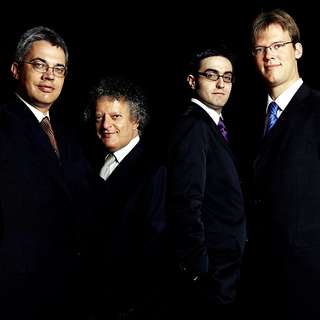|
Back
Quicksilver? No! Quarksilver! New York
Le Poisson Rouge
12/01/2009 -
Harrison Birtwistle: Second String Quartet (American premiere)
Conlon Nancarrow: Third String Quartet
Iannis Xenakis: Tetras
Arditti String Quartet: Irvine Arditti, Ashot Sarkissjan, violins; Ralf Ehlers, viola; Lucas Fels, violoncello

Arditti Quartet (© Arditti Quartet)
Le Poisson Rouge is the ultimate West Village sanctuary/asylum for music of surprise–jazz, rock, world, contemporary, unclassifiable. But hosting the Arditti String Quartet tonight had to have astonished even regular denizens of this cellar haven. Without even a written program, the cellar club brought the most fearless string players in the world, performing music of such electrifying difficulty that initially one could only sit with wonder and awe.
The wonder was compounded, since most of the crowd had settled down to enjoy drinks, sandwiches, crunchy carrots and sizzling meatballs. But when the Arditti launched into two minutes of a single note–a low E–for the start of Harrison Birtwistle’s Second String Quartet–time and space stopped completely, except for those four players from another cosmos.
That first note was hardly a stasis. The E buzzed into a universe of trills, harmonics, triple-stringing, microtones, quarter-tones and a whole thesaurus of sounds before launching into the quartet proper.
Doubtless, Mr. Birtwistle had much technical rationale for the work. For myself, hearing it for the first time, the Birtwistle was a monstrous (and often funny) perversion of the adage that a string quartet is “a conversation among friends.” This was no “conversation”. This was vicious confrontation, leading to musical ferocity. Start a pleasant viola melody, and the cello, with stormy snorts, whacked it out of the ballpark. Let the two violinists enjoy an uneasy dialogue, and viola and cellist parodied the line louder, more vehemently.
Towards the middle, the group settled down to a lovely little fugue. But that wasn’t good enough for them. The fugue went haywire, the instruments making their own sounds, breaking up phrases, pouting instead of playing. At times, there was the feeling of Leos Janácek. Not in the music itself, but that the lines came close to human voices. And not very nice human voices either.
The ending was a quietude, perhaps a truce. Mr. Arditti told me later all the instruments except cello are supposed to leave the stage. “It was too dark here,” he laughed. “We would have fallen off the stage.” True, it does finish with cellist Lucas Fels repeating a phrase over and over again with longer and longer intervals before the ending note. Like the last guest, muttering some final words before going…….to…….sleep.
After the intermission, the late Conlon Nancarrow–known for his player piano works and his mathematical jazzy music–sounded almost easy. Nancarrow was largely ignored during his lifetime, and his renaissance has come mainly from the Arditti performances, which the composer had called “Unbelievable.”
This Third String Quartet (he didn’t write a “second”) consisted mainly of fugues and canons. But what fugues! What canons! The first movement was typical. The viola started one melody, the cello entered in time, but playing it twice as fast. The second violin now played the same line twice as fast as the cellist, and when first violin Irvine Arditti himself came in, bowing that original melody at lightning speed, one could only think of a non-Euclidean physicist’s equation showing anarchy and structure existing together. Like a Well-Tempered Clavier gone wild, the rest of the quartet proceeded with its fugues, each taking an eccentric (even sometimes a jazzy or tango rhythmic) turn, yet finishing with minimalist-style raindrops.
The secret of Xenakis is to never read about a work before hearing it. Like looking at architectural blueprints (the composer was an architect), it will only confuse lines and symbols for the real structure. The real structure of Tetras (Greek for “four”) is that each of the nine sections has a totally different mood. I can’t say I understood it, but like great architecture, it sure was exciting. I loved the grand opening of glissandi and massive interactions. The second section was my favorite because Xenakis played Tom and Jerry with his instruments. It was a dictionary of cartoon noises, from flatulence to sneezes. Later, though, we had Xenakis the mystic with huge waves of sound pulsing from the auditorium, like an instrumental tsunami rushing from the stage to the enraptured audience.
Yet after the three works, one couldn’t feel so much for the composers as for this unimaginably exciting playing. Yes, now I would like to read the scores or descriptions of all three pieces by musicologists. Tonight, though, it was the revelation of four players who have a gestalt understanding of each piece they played, so even if our “understanding” was minimal, the Arditti String Quartet, overcoming almost impossible technical demands, played with a visceral energy an instinctive understanding and an infectious thrill.
The Arditti String Quartet
Harry Rolnick
|